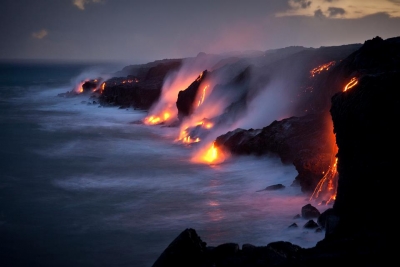
Located in Hawaii, a state in the US, the Hawaii Volcano National Park is an active volcanic area. Set up in 1961, it spreads across more than 1200 km². The region hosts two of the most active volcanoes in the world – Mauna Loa and Kilauea. While Mauna Loa is a great test volcanic mass on earth, Kilauea is considered the planet‘s most active volcano. The Park is a UNESCO World Heritage Site. The isolation of the Hawaiian archipelago, and the diversity in age, texture, and the composition of the lava flow within the region have given rise to an impressive variety of habitats which, in turn, have immensely influence the development and adaptation of the flora and fauna in the park.
Wildlife
Among the endemic, migratory, introduced, and indigenous birds in the region are francolins, pheasants, plovers, doves, babblers, thrushes, mynas, finches, canaries, sparrows, several species of honeycreepers, munias, endangered geese and hawks, and sea birds such as black noddy. The area’s native species include crickets, caterpillars, dragonflies, and sea turtles. Toads, geckos, and skinks too can be found in the area. Mammals such as mongooses, pigs, and wild goats have been introduced in the region. However, there is only one native mammal – a bat species.
Threats
Considered one of the most vulnerable in the U.S., the Hawaii Volcanoes National Park faces many threats. Among the most threatening is the problem of invasive species. It is said that the place has hosted several wildlife for centuries without any trouble. However, all that changed over 200 years ago when humans unwittingly introduced several non-native species, both plants and animals. Among the creatures causing problems to the native plants and animals are feral pigs, goats, mouflon sheep, feral cats and rats, mongoose, ants, wasps, and mosquitoes. Not just animals, even invasive plants have been a cause of great concern.
It may be hard to believe but some of the most destructive plant species of grass varieties. Grasses such as the African and South American varieties were introduced to help with grazing cattle and sheep. The seeds of these grasses are invariably spread by wind, making them easier and faster to spread but difficult to contain. These varieties are inherently strong, are resistant tofire, which are fine characteristics to have, especially since they feed cattle. But on the flip side, they smother the native grasses in their path, ultimately proving to be harmful to the native vegetation in the region.
Did you know?
Due to volcanic eruptions, the landscape of the Park is constantly changing. The flowing lava is rich in nutrients, and has the power to enrich the environment and even restore habitats that have faced degradation. But that may not be the case always, especially when the volcanic eruption is severe and continuous, without giving a habitat enough time or a chance to recover. In fact, news reports suggest that the eruption of Kilauea in 2018 could have dramatically and permanently altered the landscape of the region. It remains to be seen how (and how much) this has or could have affected the wildlife in the region.
Picture Credit : Google




